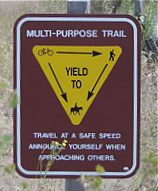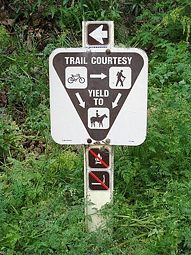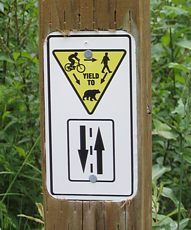RIDER ETIQUETTE: RULES OF THE TRAIL
By Mark Langton, CORBA Skills Clinic Instructor
 I
have been riding mountain bikes since 1983 and have been involved
in advocacy since 1987, so a lot of these rules of the trail are
second nature to me. As I started to write down my thoughts, I realized
that many things have changed since the CORBA Rules Of The Trail
were first penned (which just happen to be IMBA’s rules boiled down
to the bare essentials – mostly from input from our own Jim Hasenauer).
Following are the things that I tell people when asked if I have
any suggestions on proper backcountry etiquette while on a mountain
bike. These are not in any particular order of importance.
I
have been riding mountain bikes since 1983 and have been involved
in advocacy since 1987, so a lot of these rules of the trail are
second nature to me. As I started to write down my thoughts, I realized
that many things have changed since the CORBA Rules Of The Trail
were first penned (which just happen to be IMBA’s rules boiled down
to the bare essentials – mostly from input from our own Jim Hasenauer).
Following are the things that I tell people when asked if I have
any suggestions on proper backcountry etiquette while on a mountain
bike. These are not in any particular order of importance.- Slow down a little, especially in a park where there are lots of other people. Lots of cars in the parking lot equal lots of people!
- Treat others as you would like to be treated. Imagine if you were the one hiking or riding a horse.
- Scan as far ahead on the trail as possible for other trail users. Always assume there’s someone around the next corner, perhaps a small child that can’t jump out of your way.
- Announce yourself well in advance when approaching others from behind. Never assume that a hiker or equestrian hears you approaching (don’t yell “on your left” just as you’re about to pass; this is not a race course or bike path). A handlebar bell or bell tied to your saddle works well, but a cordial greeting can have the most positive effect. If a hiker or equestrian does not respond, for any number of reasons (listening to music with earphones, etc.), slow down and use care and discretion in this situation, and pass slowly. As for earphones, it is illegal to have buds in both ears at the same time when riding; one must be out.
 If you come upon a group of hikers that won’t move out of
your way, get off your bike and walk into the group, asking
nicely if you can “play through". Hikers seem to get the
golf reference.
If you come upon a group of hikers that won’t move out of
your way, get off your bike and walk into the group, asking
nicely if you can “play through". Hikers seem to get the
golf reference.- Always ask a horseback rider if it’s okay to pass. Do not assume it is okay just because you’ve told them you’re coming. Sometimes a rider needs to move off the trail and even turn the horse to face you so it isn’t scared.
- When letting an equestrian pass, stand on the low side of the trail. And always talk to the rider, whether they are passing you or they are passing you.
- Don’t skid unless absolutely necessary, which for the most part is never.
- Never cut a switchback or ride off of a trail. Doing so causes erosion and damages the trail.
- Don’t build unauthorized jumps, stunts or bonus runs.
- Know in advance where you’re going to be riding, and let someone else know too.
- Pack out more than you pack in.
- Be respectful to the neighborhoods where you park. Turn down your stereo before getting out of your vehicle.
- Avoid riding abreast on fire roads and double track as it makes it more difficult for oncoming riders to pass, especially if they’re going a bit too fast. And in National Park Service properties it’s actually illegal.
- Always carry two spare tubes; one for you, and one for the person who isn’t carrying one (and for those really bad thorn days). Patch kits are also okay, but once you open the tube of glue it’s basically worthless – often the glue dries up within a couple of days, even with the cap on.
- Be self-sufficient: Carry enough of whatever you’ll need for the entire ride. ALWAYS carry more water than you think you’ll need. Carry emergency contact and medical info, as well as your cell phone. Be sure to program an emergency contact number into your phone and “ICE”, or “In Case of Emergency.” Consider purchasing the Road I.D. which has emergency information on it.
 We’re all familiar with the “yield protocol,” right? Hikers yield
to equestrians, cyclists yield to hikers and equestrians. However,
there is no rule pertaining to who yields to whom when you’re on
a bike and encounter someone going uphill or downhill. I’ve stopped
for riders in each direction, depending on who it was easier and/or
safer for to stop. If you can pass each other safely without stopping,
go for it. But remember, when you’re on a singletrack, look at the
trail, not the rider, or you’re likely to run into the rider. Also
you should always stay to your right when passing other users coming
towards you.
We’re all familiar with the “yield protocol,” right? Hikers yield
to equestrians, cyclists yield to hikers and equestrians. However,
there is no rule pertaining to who yields to whom when you’re on
a bike and encounter someone going uphill or downhill. I’ve stopped
for riders in each direction, depending on who it was easier and/or
safer for to stop. If you can pass each other safely without stopping,
go for it. But remember, when you’re on a singletrack, look at the
trail, not the rider, or you’re likely to run into the rider. Also
you should always stay to your right when passing other users coming
towards you.Here’s what our esteemed Jim Hasenauer has to say:
“Yield means SLOWDOWN, be prepared to stop, establish communication and then pass safely. So actually, both riders yield and should be prepared to stop, and then they work out the pass. It’s similar to cars merging on the freeway. The oncoming car has to find the safe space to move into, but a car already on the freeway is likely to move over and make room. There’s no set rule who must yield uphill or downhill, but it’s been generally accepted that the rider moving downhill yields, because it’s easier for them to get started again. No one should assume that another is going to stop, dismount, et cetera. It’s all about the communication.” Bottom line: When in doubt, yield the right-of-way.
| Here’s
a compact list of the basics (and a couple of not so
basic) items you should be carrying: |
||
|
|
|
No comments:
Post a Comment